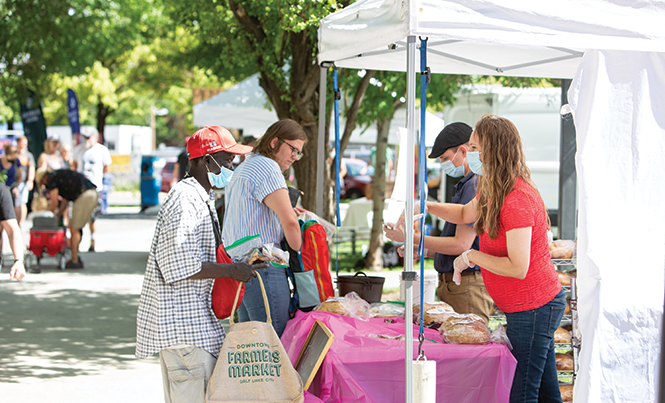Market Upturn
The Downtown SLC Farmers Market looks to get closer to normalcy.
By Scott Renshaw @scottrenshawWhile many events around the country began the process of shutting down last spring, the Downtown Farmers Market was figuring out how to keep going—a process connected to its unique status as an event with an essential-services function.
As they were for everyone, the early days of the pandemic in March 2020 were crazy for Urban Food Connections of Utah—the organization that co-produces the Farmers Market with the Downtown Alliance—and its executive director, Alison Einerson. She recalls that the Winter Market was ongoing at the time, and that they began the process of reaching out to the Department of Agriculture and other farmers' markets around the country to see what was going to be possible. "It became clear that they were going to say, 'Treat this as an essential service, like a supermarket," Einerson recalls. Unfortunately, however, the Magna earthquake hit on March 18, requiring the closure of the building that houses the Winter Market.
That still left planning for the 2020 summer market, and as the shutdown lasted longer than anyone initially expected, the logistics grew more complicated. "We realized [the pandemic] was much more serious, so how could we have a summer market," Einerson says. "We could limit to essential food, no arts & crafts, no performers, no prepared food."
According to Einhorn, the scaled-back Saturday Market proved to be a great success. With strict protocols in place—including masking of attendees and vendors, and 10-foot spacing between booths—no documented cases of COVID transmission where associated with the event throughout the summer. Additionally, while the raw numbers of attendees was down, Einhorn says that "for some farmers, they had the best sales they'd seen in years. Those who came, came to shop."
"From the attendees, the feedback we got was overwhelmingly, 'Thank you for being here. Thank you for stepping up and supporting the farmers,'" she adds. "They were going to plant whether we had a market or not. If you've got orchards, the apples are going to come, and it's hard to make the transition to providing to supermarkets."
That doesn't mean that 2020 went off without a financial impact on the organization. Eliminating the arts & crafts booth cost the organization approximately $75,000 last year, Einerson estimates, with another $60,000 lost from the absence of the prepared-food vendors. As a result, Urban Food Connections of Utah launched an online fund-raising campaign with a goal of $50,000; as of press time, approximately $30,000 has been raised. "We usually don't go to the public, because the way they help us is by supporting our vendors. We rely on the income of our vendors," Einerson says. "If we were ever going to [ask for donations], we should now."
Re-focusing the organizations efforts for 2021 has included suspending the Tuesday edition of the summer market, which Einerson says has "never really gotten popular enough to carry through." But when the Saturday Farmers Market returns on June 5, it will be in a form much more familiar to regular Pioneer Park attendees than the market required by the events of 2020. Arts & crafts booth are back, with 59 participants. Prepared food vendors are also returning, with 13 participants representing diverse international cuisines. And in keeping with the growing body of medical knowledge, dropping case counts and new CDC guidance, visitors will not be required to wear masks, and more booths will be possible due to a 5-foot spacing rather than last year's 10 feet. The expectation for increased demand has led to an expansion of the schedule from the usual 20 weeks to 21 weeks, through October 23.
That doesn't mean 2021 at the Saturday Farmers Market will look identical to pre-pandemic 2019, for example. While attendees will be able to purchase prepared food and eat on site, there will be no seating area due to an inability to insure sanitizing between parties, so visitors will have to pull up a spot on the grass. Additionally, traditional features like music performances and a bike valet area are not scheduled to be included. "We're about 75 percent of normal," Einerson adds. "We're definitely back on the right track."
Part of that track, she believes, is emphasizing the importance of locally-sourced food, especially in the wake of the pandemic that disrupted supply chains and resulted in shut-downs at meat packing plants. "If anything, this pandemic showed us how broken our food systems are," Einerson says. "You can always get local produce at a farmers' market. It's more than just a fun thing to do on a Saturday; it's incredibly meaningful to the local economy."
More by Scott Renshaw
-
Feature film review: THE BEAST
A filmmaker's compelling ideas get a bit tangled in references to his creative influences.
- Apr 17, 2024
-
Faces of Salt Lake County book and portrait reception
Images and personal stories in a new book reveal local demographic diversity
- Apr 17, 2024
-
Film Reviews: New Releases for April 12
Civil War, Escape from Germany, Coup de Chance, Hundreds of Beavers, La Chimera, Sting
- Apr 11, 2024
- More »
Latest in Arts & Entertainment
Readers also liked…
-
New TV for January 2023
Mayfair Witches, Velma, The Last of Us, Poker Face and more premieres
- Jan 4, 2023




